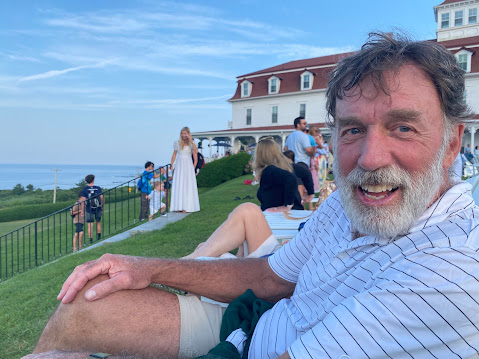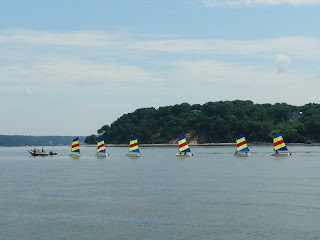What do two people do on board a small sailboat for months at a time? I’m sure that is a big mystery to you non-boating people, so let me enlighten you.
Rick and I have developed different routines while living on our boat. When we are at anchor, we entertain ourselves separately with different pastimes. Rick’s main focus is on writing, and he sits at his little desk for hours at a time, quite happily tapping away at his computer keyboard most mornings. He also spends an inordinate number of mornings swearing at his computer because it never seems to be working right. I try to stay out of his way on those occasions.
I brought sewing and weaving projects along, but have hardly touched them this year; I’m not sure why. I seem to be much more interested in obsessively reading the political news online, looking at the latest polls, etc. This has been a particularly stressful time, with a highly consequential election coming up in just a few months, and even though the fantasy is that we leave all our troubles and responsibilities at the dock, in this age of cell phones and non-stop news cycles, it has been difficult to unplug.
Cooking with any imagination is somewhat difficult on a boat, with a small galley, limited gadgetry, and a marine environment that doesn’t work well with fresh fruits and vegetables. Yes, we have an icebox with refrigeration, but only the most hearty produce survives in there. No food processor, blender or microwave. We do have an oven, but it has never worked. Those boat ovens are notoriously bad anyway, so most boaters don’t use them, and we never bothered to get ours fixed. But on a cold day, I get cravings for baked goods, muffins or banana bread. Years ago I found a little fifties-vintage stove top baker, aptly called an “Ovenette”, that sits on top of a burner and uses convection to create a small circular space in which to bake whatever you want. It’s pretty hard to regulate the temperature though, and it tends to burn things on the outside before they are done in the middle.
 |
| Pumpkin nut bread baked (burned) in the Ovenette |
We also have a thermal cooker; a giant thermos that uses retained heat to slow-cook soups and stews. Basically, you put everything in a pot, boil for five minutes, and then put the pot inside the thermos and let it sit for four to eight hours. The only problem with this method is that it works best if the pot is full. I made a delicious lentil soup using up all the remaining veggies in the fridge, but there was enough soup to feed an army. There was so much of the stuff that we could have eaten it every night for a week, and you know, almost nothing is that delicious. Good thing we had burned pumpkin bread to go with it.
 |
| Leftover Lentil Soup |
 |
“What about laundry?” you may ask. The solution to that is that you need to bring LOTS of clothing, and wear the same thing over and over, only changing when it’s just too disgusting, even for you. I brought enough underwear to have a fresh pair every day, for the whole summer, and that has worked out pretty well. But as wonderful as it is not to have to do laundry that often, there is a stickier problem; what to do with all of that dirty laundry as it builds up? A summer’s worth of undies, shorts, tee shirts, sweatshirts, sheets, towels, pillow cases, dish cloths, sleep wear, swim wear, ugh, ugh, ugh. We haven’t quite figured that one out. We stuff it all under the v-berth and into cupboards, where it stews until we can get to a laundromat.
 |
| The Joads go in to do laundry |
For me, the best thing about sailing is when we stop. I know that sounds facetious, but it really is true. When I am no longer hampered by the threat of seasickness, I am free to appreciate the constantly changing marine environment. I love to drink in the scenery when we’re anchored in a beautiful remote spot, and I love swimming off the boat on a hot day. We go ashore whenever we can, walking the beaches, visiting shops and restaurants.
We had a particularly wonderful stay in Onset, a charming little town at the southern end of the Cape Cod canal. In addition to getting our laundry done, we stopped in to Marc Anthony’s place for their signature pizza and steamed clams. We love their pizza so much, we ordered an extra to take back to the boat. Then two days later, we came in again for beer, and couldn’t resist bringing home another large pie.
I do a lot of daydreaming. We have meandering conversations about, say, how amazing it is that whales and dolphins evolved to have blow holes on the tops of their heads. How does that even work? Rick does frequent stretches and pseudo knee bends/squats, trying to get his injured knee to recover quicker.
Recently we tried out a little game, the idea of which came about years ago from my old friend Christian Colberg. I call it “Bellybutton Bagel”, and it goes like this: Take your two hands and join the thumb and forefingers together to make a circle. Use that shape to encircle your bellybutton and the tissue surrounding it, creating what looks like a bagel. Then compare with other players. Rick’s bagel was a lot hairier than mine. Okay, that used up about five minutes. What’d ya wanna do now? Is it time for lunch yet?
Is there any leftover pizza?












































